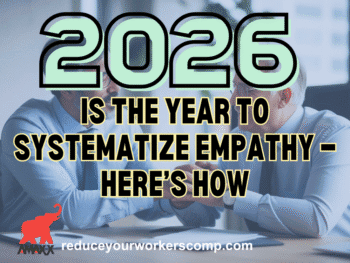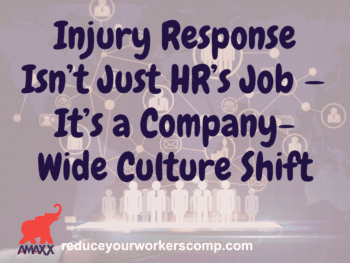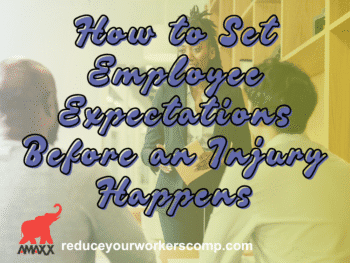
These are the same feelings that injured employees have when they are not receiving information and communication from interested stakeholders, including the claim handler on their workers’ compensation claim. One of the biggest drivers in litigation workers’ compensation program costs is the claims team not correctly communicating with the employee. Now is the time to make a radical change in your program and better communicate information following a work injury.
Types of Communication
There are two types of communication:
- Proactive communication; and
- Reactive communication.
Click Link to Access Free PDF Download
“8 ‘Think Outside the Box’ Tactics to Settle Workers’ Comp Claims”
Proactive communication relies on the person with information to share it with those who want to receive it. On the other hand, reactive communication is driven by the receiving not receiving something and demand information.
Following a work injury, the employee has countless questions:
- I am injured and cannot go back to work. Now what?
- What is my claim number, and whom do I contact regarding my workers’ compensation claim?
- When will I receive workers’ compensation benefits for missing time from work?
- Where do I go for medical care and treatment, and how do I ensure I am not stuck with the bill?
From the claim handler’s perspective, this is information one knows as they work claims daily. They know and understand the process. They need to share this information with the employee proactively instead of waiting for the employee to make contact.
Setting a Claim Up for Success Via Proactive Communication
Members of the claim management team can better position their claims by being proactive in all post-injury communications:
- Provide information regarding the workers’ compensation process. While most jurisdictions require employees are sent a prepared state packet, this information can go beyond the basics. It can be customized to include the claim number, name and contact information of the claim handler, and essential contact information.
- Ensure the employee understands the process by including easy-to-understand flow charts and a glossary of terminology.
- Provide the employee with tips on best practices for ongoing information on their claim. This can include some as simple as a folder and paper to place documents and record information. This will provide the employee with easy access to information.
Developing a high level of trust is key to controlling workers’ compensation costs. These are some simple steps that can be taken to ensure success.
Reach Out and Touch Someone
The 1987 AT&T television commercial challenges people to “reach out and touch someone” by taking the time to place a telephone call. It was important then and even more critical now.
Modern technology has made the expensive long-distance telephone call obsolete. Easy access to smartphones and the use of the Internet have multiplied how we can communicate with others. While there is a benefit to these methods of communication, they have also dehumanized the process. Taking the time to connect with the employee via the telephone can help in several ways:
- Collecting of Information: A telephone conversation allows the claim handler to gather accurate and complete information by asking follow-up questions. This also allows the claim hander to gauge the demeanor and temperament of the employee.
- Establishing a Relationship: Communication via email and text messaging is impersonal – it takes away the human element of communication.
- Gauge Next Steps: Interactions via telephone allow the claim handler to determine the next steps. This can include decisions on whether the claim will likely result in litigation.
Now is the time to reach out to the injured employees via telephone and understand what is going on in a claim.
Going the Extra Mile
There are no set rules on when a claim handler can contact an employee. Studies indicate that more frequent contact helps resolve claims promptly and ensure an amicable resolution. Other steps that should be considered include:
- Making weekly contact with an employee during the acute phases of treatment and following significant events such as surgery.
- Sending a “get well soon” card to the employee. People often dread going to the mailbox, which is usually littered with bills, unwanted solicitations, and other junk mail. Nothing brightens someone’s day more than receiving the unexpected card -especially when it says “get well soon.”
- Never forget communication with the employer. Discussions should have a focus on returning the employee to work and available options.
Conclusions
Claims are handled more effectively and efficiently when there is proactive communication coming from the claim handler. This includes calling the employee and going beyond the norms, such as sending a “get well soon” card. It is also essential to include the employer. When these steps are taken, employee morale increases, and a program can realize savings.
 Author Michael Stack, CEO Amaxx LLC. He is an expert in workers’ compensation cost containment systems and helps employers reduce their workers’ comp costs by 20% to 50%. He works as a consultant to large and mid-market clients, is a co-author of Your Ultimate Guide To Mastering Workers Comp Costs, a comprehensive step-by-step manual of cost containment strategies based on hands-on field experience, and is the founder & lead trainer of Amaxx Workers’ Comp Training Center, which offers the Certified Master of Workers’ Compensation national designation.
Author Michael Stack, CEO Amaxx LLC. He is an expert in workers’ compensation cost containment systems and helps employers reduce their workers’ comp costs by 20% to 50%. He works as a consultant to large and mid-market clients, is a co-author of Your Ultimate Guide To Mastering Workers Comp Costs, a comprehensive step-by-step manual of cost containment strategies based on hands-on field experience, and is the founder & lead trainer of Amaxx Workers’ Comp Training Center, which offers the Certified Master of Workers’ Compensation national designation.
Contact: mstack@reduceyourworkerscomp.com.
Workers’ Comp Roundup Blog: https://blog.reduceyourworkerscomp.com/
©2021 Amaxx LLC. All rights reserved under International Copyright Law.
Do not use this information without independent verification. All state laws vary. You should consult with your insurance broker, attorney, or qualified professional.

















